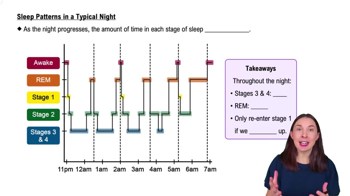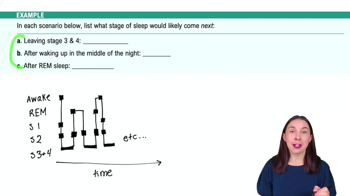Table of contents
- 1. Introduction to Psychology1h 43m
- 2. Psychology Research2h 20m
- 3. Biological Psychology2h 41m
- 4. Sensation and Perception28m
- 5. Consciousness and Sleep32m
- 6. Learning41m
- 7. Memory34m
- 8. Cognition37m
- 9. Emotion and Motivation35m
- 10. Developmental Psychology33m
- 11. Personality48m
- 12. Social Psychology41m
- 13. Stress and Health41m
- 14. Psychological Disorders44m
- 15. Treatment47m
5. Consciousness and Sleep
Sleep
Struggling with Psychology?
Join thousands of students who trust us to help them ace their exams!Watch the first videoMultiple Choice
In Hilgard's theory, the _____ remains aware of what is going on during hypnosis.
A
conscious mind
B
'hypnotized' part of the mind
C
brain stem
D
'hidden observer' part of the mind
 Verified step by step guidance
Verified step by step guidance1
Understand Hilgard's theory of hypnosis, which suggests that during hypnosis, a person's consciousness is divided into different streams.
Recognize that one of these streams is the 'hidden observer,' which remains aware of what is happening even when the person is in a hypnotic state.
Differentiate between the 'conscious mind' and the 'hidden observer.' The conscious mind is the part of the mind that is actively aware and engaged, while the 'hidden observer' is a separate stream that maintains awareness during hypnosis.
Consider the role of the 'hypnotized' part of the mind, which is the part that follows the hypnotist's suggestions and may not be fully aware of the surroundings.
Identify that the 'hidden observer' is the correct answer, as it is the part of the mind that remains aware during hypnosis according to Hilgard's theory.

 3:25m
3:25mWatch next
Master Circadian Rhythms with a bite sized video explanation from Hannah Gordils
Start learningRelated Videos
Related Practice


































































































![Race, Genes and IQ Differences | Bret Weinstein [Mini Clip]](https://img.youtube.com/vi/IztL_m3pd70/mqdefault.jpg)



































































































